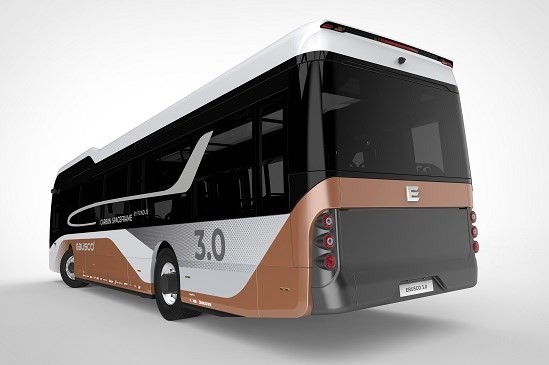Telene composite components selected for Ebusco electric city bus
Telene PDCPD polymer and low-density matrix produces durable body panels, offers lower part weight.

Photo Credit: Telene SAS
Telene SAS (Bondues, France), in partnership with bus and coach company, Ebusco (Deurne, Netherlands), have developed two composite parts for the Ebusco 3.0 electric city bus. The first part supports the large rear window, while the second part is mounted on brackets, enabling access to the electrical system.
Ebusco reportedly recognized early on the necessity of a lightweight bus structure and, in close collaboration with Pondus Operations (Deurne, Netherlands), developed the composite body-in-white (BIW) for the Ebusco 3.0. The material of choice was Telene’s poly dicyclopentadiene (PDCPD), which offered various advantages for the development of lightweight and durable body panels. Further, the material would enable a lower total cost of ownership (TCO).
Additionally, Telene’s low-viscosity resin systems (10 millipascal-seconds) are said to achieve similar injection and cycle times as high-pressure resin transfer molding (HP-RTM), but at low injection pressures. Benefits include significant threshold reduction, making fast-RTM technology accessible for electrical buses or vehicles produced in smaller series than typical automotive applications.
Ebusco 3.0 parts are roughly two meters wide and 55 and 35 centimeters wide respectively, at a thickness of three millimeters. Injection time for the parts were less than 40 seconds at 60°C, (three kilograms of resin) with pressure under 10 bars. Cycle time was less than five minutes. Note this was achieved for the initial parts without any further optimization. Post cure was performed at 130°C.
According to Ebusco, the parts show superior damage tolerance, for longer part life and reduced repair or replacement costs. Additional advantages include lower weight and elimination of release agent needs. When compared to epoxy and polyurethane, Telene’s low-density matrix resulted in lower part weight.
“The Telene team has exceeded our expectations in delivering the first Telene composite parts for Ebusco 3.0,” says Edwin van Herpt, director R&T – Composites at Pondus Operations. “We are discussing additional parts thanks to the multiple advantages Telene composites offer.”
This post is courtesy of the CompositesWorld and AZL Aachen GmbH media partnership.
Related Content
-
Schrödinger advances materials informatics for faster development of next-gen composites
Cutting time to market by multiple orders of magnitude, machine learning and physics-based approaches are combined to open new possibilities for innovations in biomaterials, fire-resistant composites, space applications, hydrogen tanks and more.
-
Optimized approach to predict delamination failure in CFRTP structures
ARRK Engineering and Mitsui Chemicals improved delamination prediction accuracy to help optimize absorbed energy/failure load for an overmolded TAFNEX CF/PP UD tape bumper beam.
-
Collier Aerospace HyperX optimizes X-59 composite nose cone
Swift Engineering relied on the CAE software’s structural sizing, analysis and test validation capabilities to deliver flight hardware for NASA’s supersonic QueSST aircraft early, under budget and with 25% weight savings.
















